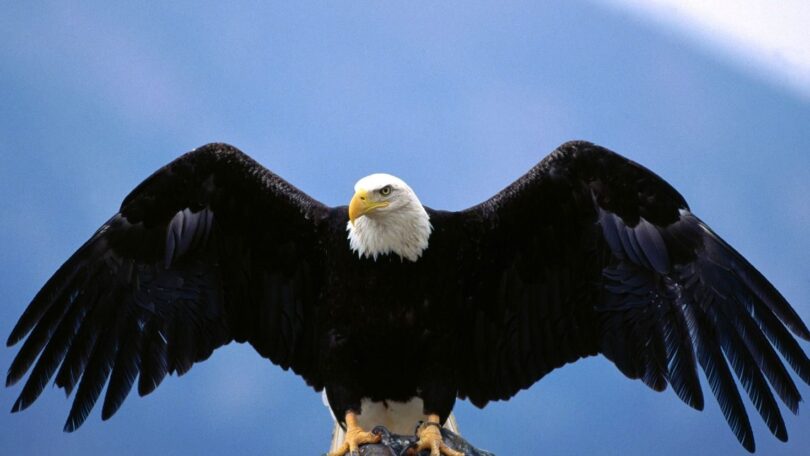Eagles, the epitome of aerial grace and power, stand as majestic symbols of the wild. These formidable birds of prey have captured the imagination of cultures worldwide, revered for their strength, keen vision, and regal bearing.
From the towering peaks of the Rockies to the vast expanses of the African savanna, eagles command attention with their awe-inspiring presence. Throughout history, eagles have held profound significance in numerous cultures, often symbolizing freedom, courage, and wisdom. In ancient mythology, they were frequently associated with deities, embodying divine qualities and serving as messengers between the mortal and immortal realms.
In this article, we delve into the world of eagles, exploring their remarkable characteristics, their role in ecosystems, and the enduring allure they hold in human culture and imagination. Join us as we soar into the realm of these magnificent birds, uncovering the secrets of their skyward domain.
Taxonomy and Classification
Eagles belong to the family Accipitridae, which encompasses a diverse array of diurnal birds of prey. Within this family, eagles are classified under the subfamily Aquilinae, alongside other large, robust raptors such as hawks and kites. The genus Aquila, derived from Latin meaning “eagle,” is home to several prominent eagle species.
Among the most well-known species is the Bald Eagle (*Haliaeetus leucocephalus*), revered as the national emblem of the United States.
With its striking white head and tail contrasting against a dark brown body, the Bald Eagle symbolizes strength and resilience.
Another iconic species is the Golden Eagle (*Aquila Chrysaetos*), renowned for its majestic presence and formidable hunting prowess.
Found across the northern hemisphere, from North America to Eurasia, the Golden Eagle is revered in various cultures as a symbol of power and nobility.
Beyond these emblematic species, eagles exhibit remarkable diversity, with over 60 recognized species inhabiting diverse habitats worldwide.
From the massive Steller’s Sea Eagle (*Haliaeetus pelagicus*) of northeastern Asia to the agile African Fish Eagle (*Haliaeetus vocifer*) patrolling the waterways of sub-Saharan Africa, each eagle species boasts unique adaptations and ecological roles.
In this section, we explore the taxonomy and classification of eagles, shedding light on the rich tapestry of species that populate the skies of every continent.
Physical Characteristics
Eagles, with their imposing stature and keen senses, exhibit a range of physical traits that distinguish them as apex predators of the avian world.
Their size varies depending on the species, with some of the largest eagles boasting wingspans exceeding 2 meters (6.5 feet) and standing over a meter tall.
One of the most striking features of eagles is their impressive wingspan, which enables them to soar effortlessly on thermal currents high above the landscape.
This expansive wingspan allows for agile flight and precise maneuverability, essential for hunting and navigating diverse habitats.
In addition to their wings, eagles are characterized by sharp, hooked beaks and powerful talons, perfectly adapted for seizing and dispatching prey.
Their keen eyesight, far superior to that of humans, allows them to spot potential prey from great distances, whether it be a small mammal scurrying through the underbrush or a fish gliding beneath the surface of a river.
Eagles also possess remarkable adaptations that contribute to their efficiency as predators. Their strong, muscular legs provide the propulsion needed for swift takeoffs and powerful dives, while their keen sense of hearing helps them locate prey hidden from view.
Furthermore, their dense plumage provides insulation against the elements during long hours spent soaring at high altitudes.
In the realm of avian predators, eagles reign supreme, their formidable physical characteristics, and keen hunting skills make them formidable hunters and revered symbols of strength and freedom.
Habitat and Distribution
Eagles are adaptable birds, found in a wide range of habitats across the globe, from dense forests and rugged mountains to expansive coastal regions and arid deserts.
Their remarkable versatility allows them to thrive in diverse ecosystems, each species carving out its niche within its preferred habitat.
In forested regions, eagles can be found soaring amidst the towering canopy, their keen eyes scanning the landscape for prey. Species like the Harpy Eagle (*Harpia harpyja*) of the Amazon rainforest are specially adapted to navigate the dense foliage in search of arboreal mammals and birds.
The mountainous terrain provides another favored habitat for eagles, offering expansive vistas and ample hunting opportunities.
Golden Eagles (*Aquila chrysaetos*), for example, are often found in rugged mountain ranges across North America, Europe, and Asia, where they hunt for small mammals and birds amidst rocky outcrops and alpine meadows.
Coastal areas are also prime hunting grounds for many eagle species, where they prey upon fish, seabirds, and other marine creatures. From the bald eagles of North America’s coastal estuaries to the White-bellied Sea Eagle (*Haliaeetus leucogaster*) of the Indian Ocean, eagles are adept fishermen, swooping down from their lofty perches to snatch prey from the water’s surface.
The distribution of eagle species varies widely, with some confined to specific regions while others range across continents. From the majestic Philippine Eagle (*Pithecophaga jefferyi*) endemic to the rainforests of the Philippines to the widespread distribution of the Steppe Eagle (*Aquila nipalensis*) across Eurasia and Africa, eagles can be found on every continent except Antarctica.
In this section, we explore the diverse habitats and global distribution of eagle species, highlighting their adaptability and resilience in the face of changing landscapes.
Behavior and Diet
Eagles, renowned for their prowess as hunters, employ a variety of techniques to capture prey, reflecting their adaptability to different environments and prey types. Their diet varies depending on the species and habitat, but most eagles are opportunistic predators, preying on a wide range of animals, from fish and small mammals to birds and reptiles.
Many eagle species are adept fishermen, relying on their keen eyesight to spot fish swimming near the water’s surface. Bald Eagles, for example, are often seen perched near lakes and rivers, scanning the water for unsuspecting prey. When a suitable target is spotted, the eagle swoops down with lightning speed, extending its talons to snatch the fish from the water.
In forested areas, eagles may hunt for small mammals and birds, employing stealth and surprise to catch their quarry. Golden Eagles, with their powerful wings and sharp talons, are skilled hunters of rabbits, hares, and ground-dwelling birds, often launching swift aerial attacks to capture their prey.
Nesting habits and mating rituals vary among eagle species, with some forming monogamous pairs that mate for life, while others engage in elaborate courtship displays to attract mates. Eagles typically construct large nests high in trees or on cliff ledges, using branches, twigs, and other materials to create sturdy platforms for raising their young.
Social behavior among eagles is often centered around the nesting site, where pairs defend their territory from intruders and compete for resources. During the breeding season, eagles may engage in aerial displays, soaring high above the landscape and calling out to potential mates.
Despite their formidable hunting skills and solitary nature, eagles also exhibit cooperative behavior, especially during the nesting season when parents work together to care for their offspring. In this way, eagles demonstrate both the fierce independence of apex predators and the bonds of family and community that sustain them in the wild.
Conservation Status
Eagles, iconic symbols of power and freedom, face a myriad of threats that endanger their survival in the wild. Despite their adaptability and resilience, many eagle species are confronted with habitat loss, pollution, human disturbance, and illegal hunting, which place them at risk of extinction.
The conservation status of eagle species varies widely, with some populations stable or even increasing, while others teeter on the brink of extinction. Species such as the Bald Eagle and White-tailed Eagle have rebounded from the brink of collapse thanks to concerted conservation efforts, including habitat protection, captive breeding programs, and restrictions on pesticide use.
However, numerous eagle species remain vulnerable or endangered, their populations dwindling due to ongoing threats. Habitat destruction, particularly deforestation and urbanization, poses a significant challenge for forest-dwelling species such as the Harpy Eagle and Philippine Eagle, whose survival depends on intact, undisturbed habitats.
Pollution, especially from pesticides and heavy metals, also poses a serious threat to eagle populations, contaminating their food sources and weakening their immune systems. Persistent organic pollutants, such as DDT, have been implicated in the decline of Bald Eagle populations in the mid-20th century, highlighting the far-reaching impact of human activities on these majestic birds.
Illegal hunting and trade further exacerbate the plight of eagles, with poachers targeting them for their feathers, talons, and other body parts prized in traditional medicine and cultural ceremonies. Despite international regulations and enforcement efforts, the illegal wildlife trade continues to thrive, driving many eagle species towards extinction.
Conservation efforts aimed at protecting eagles and their habitats are ongoing, with organizations and governments working together to address the root causes of their decline. By restoring degraded habitats, combating illegal hunting and trade, and raising awareness about the importance of eagle conservation, we can ensure a brighter future for these magnificent birds and the ecosystems they inhabit.
Notable Eagle Species
Among the diverse array of eagle species inhabiting the planet, several stand out for their remarkable characteristics and iconic status.
The Bald Eagle
(Haliaeetus leucocephalus), revered as the national symbol of the United States, is known for its distinctive white head and tail contrasting against a dark brown body. Found primarily in North America, Bald Eagles are often associated with coastal habitats, where they prey on fish and waterfowl along rivers, lakes, and estuaries.
The Golden Eagle
(Aquila chrysaetos) is renowned for its majestic presence and formidable hunting prowess. With a wingspan exceeding two meters, Golden Eagles are powerful predators found across the northern hemisphere, from North America to Eurasia. They inhabit diverse habitats, including mountains, grasslands, and open woodlands, where they hunt for small mammals and birds.
The Harpy Eagle
(Harpia harpyja) is one of the largest and most powerful eagles in the world, native to the rainforests of Central and South America. With its distinctive black and white plumage and massive talons, the Harpy Eagle is a formidable apex predator, preying on sloths, monkeys, and other arboreal mammals. Despite its impressive size, the Harpy Eagle is a master of stealth, gliding silently through the forest canopy in search of prey.
These notable eagle species exemplify the diversity and adaptability of these magnificent birds, each occupying a unique niche within its respective habitat. From the soaring cliffs of North America to the dense jungles of South America, eagles continue to captivate and inspire with their grace, power, and untamed spirit.
Eagles in Culture and Mythology
Throughout history, eagles have occupied a prominent place in the mythologies, folklore, and art of cultures around the world. Revered for their strength, majesty, and keen eyesight, eagles have been depicted as symbols of power, freedom, and transcendence.
In ancient civilizations such as Greece and Rome, eagles were associated with the gods, often serving as messengers or companions to deities such as Zeus and Jupiter. The Roman Empire adopted the eagle as its emblem, symbolizing the empire’s strength and authority, and legions carried eagle standards into battle as symbols of honor and valor.
In Native American cultures, eagles are revered as spiritual beings and symbols of connection to the divine. Tribes such as the Lakota, Hopi, and Haida view eagles as messengers between the earthly and spiritual realms, with their soaring flights representing the journey of the soul. Feathers from eagles are considered sacred and are used in ceremonies and rituals to invoke blessings and protection.
In Norse mythology, the eagle is associated with Odin, the god of wisdom and war, who was often depicted with an eagle perched on his shoulder. The eagle was seen as a symbol of Odin’s omniscience and authority, as well as his ability to traverse between the realms of the gods and mortals.
In art and literature, eagles have been depicted in various forms, from the regal portraits of Bald Eagles adorning American currency to the soaring sculptures of eagles gracing public monuments and buildings. Artists such as John James Audubon and Albert Bierstadt captured the beauty and majesty of eagles in their paintings, immortalizing these iconic birds in the annals of art history.
Across cultures and throughout history, eagles have captivated the human imagination with their grace, power, and indomitable spirit, embodying the timeless ideals of strength, freedom, and transcendence. As symbols of the wild and the untamed spirit of nature, eagles continue to inspire awe and reverence in people around the world.
Eagle Watching and Tourism
Eagle watching has emerged as a popular ecotourism activity, offering enthusiasts the opportunity to observe these majestic birds in their natural habitat. Each year, thousands of nature lovers flock to prime locations around the world to witness the breathtaking spectacle of eagles soaring through the skies and hunting for prey.
One of the premier destinations for eagle watching is the Chilkat Bald Eagle Preserve in Alaska, where hundreds of Bald Eagles congregate along the Chilkat River during the winter months to feed on spawning salmon. The spectacle of scores of eagles perched in trees and swooping down to snatch fish from the water is a sight to behold and draws visitors from around the globe.
In Africa, the Kruger National Park in South Africa and the Maasai Mara in Kenya are renowned for their populations of African Fish Eagles, which can be seen soaring above rivers and lakes in search of fish.
In Europe, the Strait of Gibraltar serves as a major migratory route for raptors, including the impressive Griffon Vulture and Spanish Imperial Eagle, offering birdwatchers a chance to witness the annual spectacle of thousands of birds crossing between Europe and Africa.
Whether it’s witnessing the majestic Bald Eagles of North America, the iconic Golden Eagles of Europe, or the graceful African Fish Eagles of Africa, eagle watching provides a unique opportunity to connect with nature and experience the wonder of the avian world.
Human Interaction and Conflict
As human populations expand and encroach upon natural habitats, eagles increasingly find themselves in conflict with human activities, leading to challenges for both eagles and humans alike.
One significant source of conflict arises from habitat loss and fragmentation, as urbanization, agriculture, and infrastructure development encroach upon eagle territories, depriving them of essential nesting sites and hunting grounds. Fragmentation of habitat can disrupt breeding patterns and reduce prey availability, leading to declines in eagle populations.
Another source of conflict stems from human activities such as hunting, poisoning, and disturbance, which pose direct threats to eagle populations. Illegal hunting and trade of eagles for their feathers, talons, and other body parts continue to occur, despite legal protections and conservation efforts.
Conservation organizations and government agencies are implementing various strategies to mitigate human impact on eagle populations. These efforts include habitat restoration and protection, establishment of protected areas and wildlife corridors, and public education and outreach campaigns to raise awareness about the importance of eagle conservation.
Furthermore, measures such as banning harmful pesticides and enforcing regulations against hunting and trade of eagles are crucial for safeguarding their populations. Collaborative initiatives involving local communities, conservation groups, and government agencies are essential for addressing the complex challenges facing eagle populations and ensuring their long-term survival in the face of increasing human pressures.
By fostering coexistence between humans and eagles and implementing sustainable land management practices, we can help mitigate conflicts and ensure a future where eagles continue to soar majestically in the wild.
FAQs about Eagles
1. What do eagles eat?
Eagles are opportunistic predators and their diet varies depending on the species and habitat. Most eagles primarily feed on fish, small mammals, birds, and carrion. For example, Bald Eagles are known for their affinity for fish and often hunt along rivers, lakes, and coastal areas, while Golden Eagles are skilled hunters of rabbits, hares, and ground-dwelling birds. However, eagles are known to adapt their diet based on availability, and some species may also prey on reptiles, amphibians, and insects.
2. How long do eagles live?
The lifespan of eagles varies depending on factors such as species, habitat, and environmental conditions. On average, eagles in the wild can live anywhere from 20 to 30 years, although some individuals have been known to live much longer. Captive eagles may have longer lifespans due to access to veterinary care and protection from predators and environmental hazards. For example, Bald Eagles in captivity have been known to live up to 50 years or more.
3. How do eagles build their nests?
Eagles construct large nests, known as eyries, high in trees, on cliffs, or atop tall structures such as power poles or cell towers. They typically use branches, twigs, and other materials to create sturdy platforms for nesting. The size and construction of eagle nests vary depending on the species and habitat, with some nests reaching several meters in diameter and weighing hundreds of kilograms.
4. Are all eagles bald?
No, not all eagles are bald. The name “Bald Eagle” refers to the distinctive white head and tail feathers of mature adults, which contrast with their dark brown body plumage. However, many other eagle species, such as the Golden Eagle and Harpy Eagle, have fully feathered heads and are not bald.
5. Do eagles migrate?
While some eagle species are migratory and travel long distances between breeding and wintering grounds, others are resident and remain in the same area year-round. Migration patterns vary depending on factors such as food availability, climate, and breeding behavior. For example, Bald Eagles in North America may migrate southward during the winter months to areas with milder climates and abundant food sources, while Golden Eagles in Europe may undertake seasonal migrations between breeding and wintering grounds.







Leave a Comment